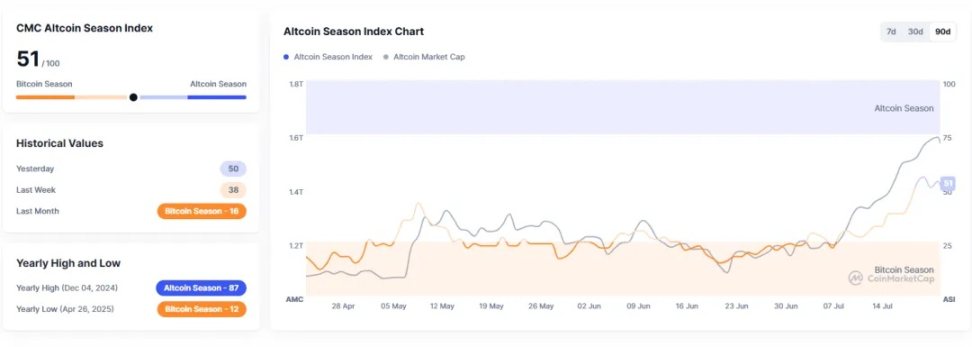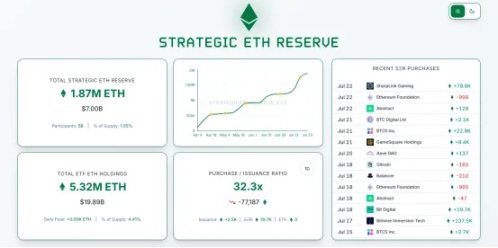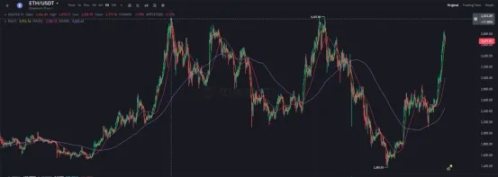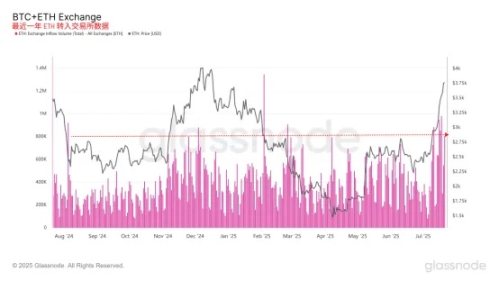Author: Tuo Luo Finance
In July, the brightest star in the market is undoubtedly Ethereum.
In terms of growth, Ethereum surged over 60% in July, a rare occurrence that surpassed the leading Bitcoin. If we extend the timeline, the contrast becomes even more pronounced; since the lowest point in April this year, Ethereum has nearly increased by 180%, while Bitcoin has risen by 65.3% during the same period. The changes brought about are evident; in the market, "V God" has made a comeback, transitioning from V God to Vitalik and then to little V, even at one point going unnoticed at conferences. From deification to disillusionment, the market image of the founder seems to fluctuate with the price of ETH.
The explosive growth instills confidence, but ETH holders, who have been scared by past events, are also feeling anxious. This sense of crisis peaked when Sun Yuchen sold ETH. Can Ethereum continue to rise? How high can it go?
As a barometer for altcoins and the spotlight of the market, the focus has once again turned to ETH.
In May of this year, Ethereum made headlines on Douyin after a 40% surge in just three days. At that time, the market was filled with a sense of impending altcoin season. However, after moving from $1800 to $2700, Ethereum once again disappointed the market. Unlike Bitcoin, which surged strongly, Ethereum lingered around the $2500 mark for nearly two months, leaving holders to quietly watch Bitcoin's price soar, filled with mixed emotions.
In reality, what everyone in the market cares about is not Bitcoin, which is hitting new highs daily, but rather this half-dead Ethereum. As BTC reached $120,000, the distance for retail investors felt like a chasm; they were pained by the high prices and drained by Bitcoin's siphoning effect. The market believes that only Ethereum can bring about ecological effects, reviving the stagnant altcoin and MEME markets. The contrast is stark: when BTC rises, the community is silent; when ETH rises, community engagement doubles. However, at that time, the market's confidence in Ethereum could only be described as weak.
As July arrived, things took a turn. Suddenly, Ethereum became hot, soaring from $2400 to $3860, achieving over 60% growth in one go. The impact was visually apparent, with the DeFi sector's monthly return exceeding 40%, and even NFTs breaking their curse, with total market capitalization rising above $6 billion, and Cryptopunks being heavily bought. It seems that the altcoin season is approaching, with the altcoin season index on Coinmarketcap reaching 55, indicating that in the past 90 days, 55 of the top 100 coins by market cap had gains exceeding Bitcoin.

Multiple factors contributed to the rise of ETH, including macroeconomic improvements, policy openness, institutional participation, and its own valuation, all of which are important components. However, even so, capital-driven factors remain the primary reason.
The Ethereum spot ETF serves as a good observation window. According to ETF data, from July 3 to July 21, the ETF experienced net inflows for 12 consecutive trading days, with a net inflow of $3.57 billion in July, setting a record for the highest monthly inflow into ETFs. This growth is clearly positively correlated with Ethereum's price. Notably, all issuers hold a net position of 5,038,016 ETH, accounting for approximately 4.32% of Ethereum's market cap. Among them, BlackRock holds the most, with 2,460,760 ETH, nearly half of the total. In other words, to some extent, BlackRock's investors have become the largest institutional holders of Ethereum. From BlackRock's recent application to the SEC for Ethereum staking, it appears that their bets will continue.
In addition to indirectly holding through ETFs, the trend of Bitcoin treasury has also reached Ethereum. Institutions such as SharpLink Gaming, BitMine, Bit Digital, BTCS, and GameSquare are all laying out Ethereum treasuries. According to Strategic ETH Reserve data, there are already 59 entities holding over 100 ETH, collectively holding more than 1.87 million ETH, valued at $7 billion, which is equivalent to 35.19% of the overall ETH ETF scale. Among them, early Ethereum supporter SharpLink Gaming holds the most ETH, reaching 360,800, followed by mining company BitMine Immersion Technologies, which holds a total of 300,000, surpassing the Ethereum Foundation (238,500) to become the largest institutional holder of ETH globally.

In terms of strategy, Ethereum treasuries share similarities and differences with Bitcoin treasuries. On one hand, listed companies typically accumulate funds quickly through debt or equity financing to hold coins. On the other hand, unlike traditional Bitcoin treasuries that rely on market cap premiums to boost stock profits, institutions like SBET and BMNR have adopted a staking and earning approach to profit. In simple terms, unlike the first type that fully bets on market cap speculation and abandons core business operations, institutions with larger holdings view Ethereum as an investment method while maintaining their original business, supplementing their operations through staking rather than replacing them.
With the continued development of ETFs and reserve strategies, Ethereum has successfully gained incremental growth from buying pressure, achieving a leap in price. However, the reason why institutions are bullish on ETH with real money comes from its internal and external narrative growth points.
From the macro environment, although it is almost certain that there will be no interest rate cuts this month, the U.S. labor market is slowing down, and there is already a consensus divide within the Federal Reserve. Waller, seen as a shadow chairman, advocates for an immediate rate cut in July; the majority led by Powell is concerned about inflation caused by tariffs and tends to wait and see; a more hardline faction believes that there should be no rate cuts throughout 2025. Currently, the market generally agrees that there will be 1-2 rate cuts this year, and if Waller takes office, the rate cut may be further increased.
Policy narratives are also beneficial for Ethereum's development. In the recently passed three major U.S. cryptocurrency bills, the anti-CBDC regulatory bill lays the ideological foundation for cryptocurrencies, providing clear legal protection for DeFi, while the already legislated stablecoin genius bill directly benefits the stablecoin sector. It can be said that these three bills establish the dominant position of cryptocurrencies in the U.S. digital currency strategy, favoring the entry of traditional institutions. In this context, stablecoins and RWA are the current consensus's promising tracks, both of which are centered around Ethereum. The proportion of stablecoin market cap on the Ethereum chain is as high as 50%, while RWA is even higher, with $7.5 billion issued on Ethereum, achieving a market share of 58.7%.
With real money buying pressure from the front and a continuous narrative supporting from the back, combined with the already low valuations, multiple factors have contributed to the recent surge in Ethereum. However, perhaps having been through too many painful experiences, holders are also feeling anxious as Ethereum slightly retreated after touching $3860.
This anxiety is not unfounded. Comparing the price dynamics of Bitcoin and Ethereum, the latter is far less recognized in value than "digital gold," often referred to as blue-chip tech stocks or "digital silver." The price performance of the two also shows stark differences. BTC has been breaking records, while $4000 has become a key resistance level for Ethereum's sell orders. In March 2024, Ethereum reached $4093, then fell back to $2890. The last time Ethereum approached $4000 was in December last year, after which it plummeted like a roller coaster to $1385, leaving many standing guard at the peak. In this context, the selling pressure at $4000 is quite significant.

This anxiety is also reflected in the data. According to Glassnode, the amount of Ethereum entering exchanges has been steadily increasing after the price exceeded $2400. Data from the validator queue tracking site Validatorqueue shows that as of Tuesday afternoon U.S. time, approximately 519,000 ETH (valued at $1.92 billion at current prices) are queued to exit the staking network. This is the largest exit queue size since January 2024, causing withdrawal delays to extend beyond 9 days. Based on past experience, unstaking is usually a precursor to selling. Additionally, the decline of the altcoin index also reflects that investors are gradually regaining rationality from FOMO.

Interestingly, Sun Yuchen, who has been known for multiple market tops, high selling, and low buying, seems to be selling ETH. In the past week, 160,600 ETH (approximately $518 million) flowed from HTX to Binance, while in April, Sun Yuchen stated he had no intention of selling ETH. This news has led to ongoing speculation in the market: has Sun predicted another top?
However, overall, aside from this top KOL selling, most capital is supporting with their feet. Especially BlackRock, which has already taken on the role of a strong institutional player in Ethereum, saw a net inflow of 160,000 ETH on July 18, breaking previous records. ARK Invest and SBET are still increasing their ETH exposure; ARK Invest has acquired 4,773,444 shares of BitMine common stock (BMNR), valued at $182 million, and BitMine plans to use all net profits to purchase Ethereum. Meanwhile, SharpLink Gaming has increased its holdings by 24,900 ETH since last Thursday, and Varys' venture capital director even made a bet with Multicoin on whether ETH can reach $10,000 by the end of 2026. These actions all reflect the strong bullish sentiment among institutions. Interestingly, while Bitcoin ETFs are seeing outflows, ETH ETFs are experiencing inflows, reflecting the undercurrents in the market.
This actually reflects the difference between this rise and previous ones. Essentially, ETH is retracing BTC's old path, with pricing power gradually transitioning from crypto giants to Wall Street institutions. Previously, ETH did not experience significant volatility due to the dispersion of holdings and lack of attractiveness. However, now, with regulatory easing, institutional buying is accelerating this process. A typical example is that even with 519,000 ETH exiting Ethereum's POS, there are also 357,000 ETH waiting to enter the network, with this new demand largely coming from treasury companies. According to Bitwise CIO Matt Hougan's prediction, ETPs and financial companies will purchase $20 billion worth of ETH next year, which, at current prices, equates to 5.33 million ETH, or seven times the net new supply during the same period.
Objectively speaking, the current crypto market does not have clear bearish signals in the medium term. Interest rate cuts are imminent, legislation is continuously advancing, and new investors are consistently increasing. From this perspective, even if the upward momentum is currently lacking, a significant drop also lacks a foundation. Of course, localized pullbacks and peaks will inevitably occur, and hedging at critical positions would be a more cautious approach.
Unfortunately, if Ethereum's rise is purely driven by ETFs or institutions, ETH may follow the same script as BTC. With limited spillover effects, the altcoin season, which urgently needs capital recovery, remains uncertain as to when it will arrive.
免责声明:本文章仅代表作者个人观点,不代表本平台的立场和观点。本文章仅供信息分享,不构成对任何人的任何投资建议。用户与作者之间的任何争议,与本平台无关。如网页中刊载的文章或图片涉及侵权,请提供相关的权利证明和身份证明发送邮件到support@aicoin.com,本平台相关工作人员将会进行核查。




